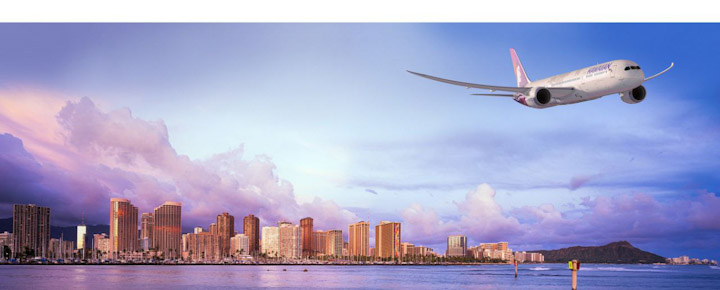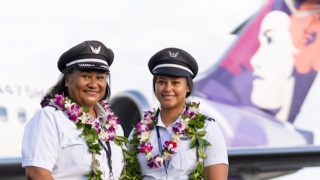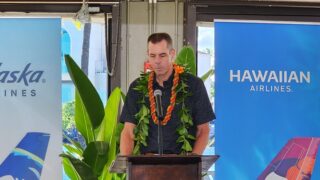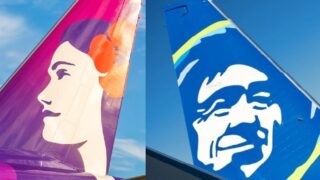Hawaiian Airlines employees are in limbo. Once defined by widebody pride and an island identity all their own, the company is now shifting under Alaska Airlines’ ownership, and the uncertainty cuts deep. Active and retired flight attendants describe co-workers as “going through it,” with no clear sense of what their future holds. For many, this is not just about airplanes.
Hawaiian’s collapse was already underway.
Years of questionable leadership decisions left the airline weakened long before Alaska appeared.
Under its last CEO, who departed with a reported $13M golden parachute (that still rankles employees and the traveling public), the company lurched from one questionable decision to another. Staff watched as leadership cashed out. The bitterness from that disconnect has not gone away.
International travel eroded and never returned the way Hawaiian thought it would. Japan’s demand collapsed, and the weak yen made Hawaii even more painfully expensive for visitors, even as flights resumed. Australia and New Zealand have faced similar conversion rate headwinds, making Hawaii trips harder to justify despite interest returning. Even Canada, a long-standing, strong source market, has been affected by the same currency drag and political headwinds.
A costly Dreamliner order that the airline could not afford made little sense for its size or balance sheet. Hawaiian had neither the routes nor the revenue base to justify ten new long haul aircraft, in addition to their oversized fleet of 24 A330 widebodies. That decision left the company more exposed.
When COVID hit, it slammed Hawaiian harder than almost any other U.S. carrier. Add in A321neo engine problems, airspace disruptions in Hawaii, and a bruising fare war with Southwest, and it was clear the airline was heading toward bankruptcy or even dissolution.
Alaska was the only buyer that showed interest. Without them, there might not be any Hawaiian Airlines left to argue over today.
Pride in widebody flying.
For decades, Hawaiian’s identity rested on its long haul routes. Flight attendants, pilots, and ground crews built entire careers around flying the A330 to Japan, Korea, Australia, and the mainland. Some of the flight attendants and others we know personally at BOH spent their entire working lives on those widebody flights, building careers that were as steady as they were proud.
The long awaited 787 was supposed to be the next chapter. Instead, those aircraft are being repositioned under Alaska’s control, and the disappointment remains raw. For employees, this feels like the loss of more than jobs or routes. It is the loss of pride in the work they loved most, and in the part of Hawaiian that connected the islands to the wider world.
That pride is not simply nostalgia, as some commenters have dismissed it. Widebody service was Hawaiian’s showcase, with cabins that set the tone for visitors arriving in and departing from Hawaii. It was where the airline’s culture was on display at its highest level. To many inside the company, seeing that slip away under Alaska feels like a demotion of everything they built over decades of service.
A pilot’s perspective.
We have also heard repeatedly from a retired Hawaiian pilot and longtime reader who has experienced these changes firsthand. His take is more cautious than fearful. He points out that Hawaii can only support so much growth, and Hawaiian had already taken the market about as far as any one airline could.
In his view, pairing Hawaiian’s international experience and powerful brand with Alaska’s scale and mainland feed may be the only way to keep the spirit of Hawaiian Airlines alive. He keeps returning to the same warning. This merger has potential, if Alaska does not blow it.
He has often said that the Hawaiian brand itself is a significant advantage, particularly in Asia and on the East Coast. He argues that even flights not bound for Hawaii might sell better under the Hawaiian name. Alaska, he believes, would be foolish not to use that brand strategically where it has the most pull. For him, the future success of the deal hinges as much on marketing wisdom as on fleet management.
Alaska’s strategy is in plain view.
From Alaska’s side, the strategy is straightforward. They intend to take control of the 787 fleet and consolidate the most lucrative long haul flying through their hubs, especially Seattle. At the same time, they have promised to keep Hawaiian’s A330s active in Honolulu and other major markets.
For many employees, that may not resemble the global future they once envisioned for Hawaiian. Still, it does mean higher aircraft utilization, stronger connectivity, and more reliable economics for the combined airline.
Several past and current employees have told us they see opportunity in that plan. With Seattle feed added to Honolulu flying, Hawaii travelers could gain access to a far wider network of one stop connections than Hawaiian alone could have ever supported.
It may not be the standalone empire some hoped for, but it could still leave Hawaii residents and visitors with more options than before. The question now is whether Alaska can deliver those choices without eroding the Hawaiian identity that made the airline matter in the first place.
The culture clash.
Even if the math adds up, the culture clash remains real. Hawaiian has long sold itself as an ambassador of the islands, wrapping service in aloha and making each flight an extension of Hawaii itself. Alaska, while being long respected in the Hawaiian community, has a very different culture, one built on domestic consistency and tight operations. Employees fear that what makes Hawaiian unique will get flattened in the transition.
The question now is whether Alaska can or will protect Hawaiian Airlines’ soul while still achieving its own growth plans.
Labor, bases, and arbitration.
Inside any merger, seniority and base assignments are where emotions run hottest. Flight attendants are already worrying about whether their long haul work will shift north. Pilots are waiting to see how worrisome seniority integration is handled. One pilot put it bluntly. These fights can destroy a merger if left to rumor and emotion. The advice is to let arbitration do its work, accept that some will be unhappy, and move forward. That is not flashy, but it is the reality of airline integrations.
What remains uniquely Hawaiian.
If Alaska is wise, it will double down on what Hawaiian does best. That means protecting the service culture, investing in Honolulu, and keeping the Hawaiian name visible in markets where it resonates most. There is also plenty of life left in the A330 fleet, and widebody service to Hawaii can remain strong if Alaska allocates aircraft where demand justifies it.
The Hawaiian name still carries weight in Asia and across the Pacific, where visitors remember it as a bridge to the islands. It also matters in New York and even in now-cancelled Boston, where Hawaiian built loyalty by going head to head with larger carriers. If Alaska leverages that power rather than burying it, the merger could strengthen both airlines.
Cautious hope or doom and gloom?
Some see reason for cautious hope. Hawaiian alone had nowhere left to go, and Alaska on its own could not have leapt so quickly into widebody international flying. Together, the combination creates a chance for something more substantial, if leadership is visionary enough not to squander it.
At the same time, employees are justified in grieving the loss of what gave them the most pride. Some readers tell us we focus too much on doom and gloom, while others insist we are not blunt enough about the risks. The truth lies somewhere in between. Hawaiian was on the brink before Alaska stepped in, and the sale prevented an ugly collapse. Both things can be true.
What to watch next.
In the months ahead, watch where the 787s actually fly and whether Hawaiian crews and branding stay attached to any marquee routes. See if the A330s continue to anchor the biggest Hawaii markets. Follow how seniority integration plays out and whether those decisions are respected on both sides. Most of all, watch how Alaska chooses to use the Hawaiian name. If it stays front and center where it matters most, Hawaiian’s spirit may still shine through.
For now, Hawaiian employees are left between fear and cautious optimism. Some feel their best days are behind them. Others believe the merger could unlock opportunities that were previously impossible. The only certainty is that the future of Hawaii’s hometown airline now rests in Alaska’s hands.
What do you think? Can Alaska preserve what makes Hawaiian special, or is this the end of the road for Hawaii’s hometown airline?
Get Breaking Hawaii Travel News







It never occurred to anyone to retire the Alaska name and become one global Hawaiian Airlines? Problems solved all the way around. People dream of Hawaii, not Alaska…..Alaska has no recognition in Asia and the South Pacific…..keeping the name Hawaiian would make that whole brand an instant power house if they don’t hire another idiot like Peter Ingram to ruin it……This merger has the potential to shine…..but Alaska name must be retired
Hawaiian employees should be happy just to have a job and that Hawaiian airlines, Now Alaska airlines should be so great to buy Hawaiian so it could continue flying ….
230 is the magic number between the 49th and 50th states admission dates to the United States. And both noncontiguous.
There’s symmetry and maybe harmony.
Now, with that CEO dude who ran off with an unlucky $13m, maybe that’s a blessing. As-in, take out the trash to bring in the cash.
We can only hope so.
The spirit of aloha will never die.The people and employees of Hawaiian have the blood life of a culture that can never be bought. Alaska will learn how a love of the islands and a life of all its people is their gain.
That was a really well done article giving a balanced view of the merger situation. Many assume that Alaska will just subsume the Hawaiian brand much like it did Virgin America. But I don’t think that’s the intent or likely outcome with Hawaiian Air. One of the things I’d like to point out is that Alaska, besides being the name of the airline, is also at the heart of the airline itself. Many folks are focusing on the Seattle hub and forget that Alaska’s roots are from the State of Alaska. There’s a lot of commonality between how Alaska Air currently operates its Alaskan hubs. Do you know of any other major airline in the US that has a flight that’s less than 15 minutes long, operated with a 737? Or that allows fish boxes to be checked for free? Or for that matter paints their planes with a giant salmon? There’s a certain pride that Alaska takes in being unique, and I think keeping separate brands, and hopefully cultures, will allow the combined airline to thrive.
Agreed 👍
PDX is OK, SFO has improved some with terminal modernization.
SAN is very cramped, and LAX is just a horrible experience no matter what. Unfortunately we cannot always avoid it when flying to LIH. Almost makes you want to go back to the days of flying to HNL and connecting there. At least at HNL you can enjoy the tropical Pacific air, and the scent of plumeria when changing aircraft.
A cultural bond is something Hawai‘i understands deeply, but a mainland corporate machine may not even have the category for it. That tension is part of why the loss feels so raw.
Agreed, but Alaska is far from a typical mainland airline. After all, it has kept the Alaska name and the Eskimo on the tail for many years. Arguably, they should have changes the name toSeattle Airlines 20 years ago, but they didn’t.
Nobody seems to be concerned about the planned cabin refresh on the A330. Will they retain seatback entertainment? I could see a scenario where they flip the entertainment in the cabin, providing suites with video monitors but economy without, particularly with Starlink. I could also see a sub fleet of international A330s that include screens with a domestic configuration without them (and potentially with Alaska’s signature Recaro “hard as rocks” seats). Waiting with baited breath to see what they unveil…
Let’s hope they keep 2-4-2 across seating and seatback monitors. Hawaiian ordered their new 787 fleet with 3-3-3 across seating.
All planes seem to have thin seatbacks now, and the bottom cushions are not much better. I have a memory foam seat cushion that I bring on all flight now. It saves my legs and __ from becoming numb.
Good article on this very sensitive subject. Your retired HA pilot has analyzed the situation correctly. Over the last decade serious management mistakes at HA were inexcusable in many ways, and the buyouts and golden parachutes for the former CEO and HA executive leadership is beyond shameful, given the financial condition of the airline. Yes, the future of the merged Airline has some real potential, as long as AS doesn’t blow it. The Seattle hub is not the answer for everything. People in the central and southern part of the Mainland, are not going to fly through Seattle on
AS metal, when AA, DL and UA have more convenient non-stops and connections from numerous interior mainland airports.
SEA-TAC is saturated, overcrowded, and not a pleasant experience for many air travelers.
Don’t overlook the fact that Alaska also has hubs/focus cities in Portland, San Francisco, Los Angeles, and San Diego.
Alaska is a West Coast powerhouse. It adapts quickly and knows how to compete agains the “Big 4.” The new Alaska is well-positioned to strengthen Hawaiian Airlines for long-term success.
No offense, but with the exception of Portland, these other hubs are even more saturated than SEATAC. I flew these airports until the pandemic, now I avoid them like the plague.
Aunties/Unc’s with tenure at HA are not going to learn a new plane, simple as that. Alaska is counting on it to reduce headcount without looking bad. They already on the radar for Virgin America mess.
Hawaiian employees must recognize that with Alaska and Hawaiian soon becoming one company, adapting to change is essential for survival in a highly competitive airline industry. While Hawaiian’s identity should remain rooted in the islands, Alaska will likely lead domestic and international routes, consolidating operations much like other major carriers with centralized hubs. This could mean the relocation of resources such as the training center to Seattle, requiring employees to make personal sacrifices, just as Alaska’s integration of Virgin America proved possible in less than two years. Marketing will be critical in merging Hawaiian’s cultural hospitality with Alaska’s expansive network, aligning both brands under a shared mission and core values to build trust with customers and pride among employees. Though challenging, this transition presents an opportunity for Hawaiian workers to shift their mindset, embrace new ideas, and help create a stronger, more unified airline.
I sincerely hope that Alaskan Airlines will do well by Hawaiian. I understand the concern of the Hawaiian employees, mergers may not always be fair or what we want. We have always driven to Seattle and flown via a Hawaiian Airlines to Maui or Kauai and we have found that we love there Aloha spirit, their meals and drinks are pretty good. This year we’re flying Alaskan via Seattle and have to do a red eye home unfortunately, so I guess we’ll figure out the difference very quickly. There’s lots going on in those beautiful Hawaiian islands and we hope we can continue to visit in the future.
The airlines’ names are:
Alaska Airlines (Not Alaskan!)
Hawaiian Airlines
Mahalo
Change always brings uncertainty and fear.
We just returned from a 5-day trip to Las Vegas on Hawaiian A-320s and thought the service was excellent and the jet was in like-new condition.
Earlier this year we flew to New Zealand/Australia on Hawaiian’s A-330s. They were clean and comfortable, and I prefer their 2-4-2 across seating to the new 787s which will all have 3-3-3 across seating. By choosing 9-across seating, they will gain an extra seat in each row, but it comes with narrower seats and aisles.
Love me some Hawaiian Airlines! Always my first choice!
Aloha Alex, exactly. I’ve got a few million miles on A330,787-9, and now increasingly A350 and take the A330 any day over Boeing. For exactly the reason you specify. 3 – 3 – 3 is simply atrocious, even in a premium carrier like JAL. And I Love HA’s old premium section. Given that real “premium economy” is now priced almost like business/first.
JAL B787’s are 8 abreast as in 2-4-2.
I’m pretty sure JAL uses 8-across seating on international flights and 9-across seating on domestic-only 787s.
I hope everything works out for the employees and wish them the best. Personally, our flight to Maui in September of 24 lacked the aloha spirit it once had. As a consumer this merger makes no difference to me. Maui has been our once a year travel destination for many years. But, with all that has happened and is happening we’re looking elsewhere for the future.
Wow, what will Hawaii do now when there is no airlines that are based in Hawaii for the people. But was this the plan all along?
I’ve seen mergers do very well for all the companies involved, and I’ve seen it tank. It all boils down to what decisions the corporate office and it’s executives make. First and foremost is to maximize profits while minimizing spending. After that, take a look at their respective markets and see what can be improved and what might be better to eliminate. Hawaiian is a niche airline. It prides itself on service and the whole Aloha experience. That has to remain for them to be successful.
Aloha~ Thanks for a nice balanced article into an issue with deep emotional ties. Having lived thru 2 airline mergers i understand the uncertainty that faces the Hawaiian employees. I had to give up my beloved PSA and move forward. And USAir had no intention of keeping the best, just hammering down their antiquated systems and aircraft! Hang in there Hawaiian people it will get better down the road. Cheers